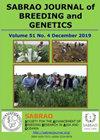AEGILOPS L. GENETIC DIVERSITY IN SOUTHWESTERN REGION OF UZBEKISTAN
IF 1.6
Q3 PLANT SCIENCES
引用次数: 0
Abstract
As wheat donors, wild species of the genus Aegilops L. play a vital role in practical breeding to improve wheat production because of their strong relationship and wide genetic diversity. Using nine simple sequence repeat (SSR) markers helped assess the genetic diversity in 96 collected samples of four species belonging to the genus Aegilops, i.e., Aegilops tauschii Coss (D), Ae. cylindrica Host (CD), Ae. crassa Boiss (DDM), and Ae. triuncialis L. (UC). The said collection came from 21 sites of various expeditions located in three regions of Southwestern Uzbekistan (Samarkand, Urgut, Kitab, and Shakhrisabz regions). Generally, 102 distinct alleles were found, with an average of 11.33 alleles per primer. The total number of species-specific amplicons was 35. The polymorphism detected varied from 28.6% (for the WSP107 primer) to 77.0% (for the WSP130 and WSP192 primers). The mean values of polymorphism information content (PIC) and expected heterozygosity (Ho) for all samples were 0.675 and 0.527, respectively. Based on nine SSR markers, on average, the genetic distance indices (GD) varied from 0.63 to 0.77. The highest genetic similarity (GD = 0.77) recorded occurred between the species Ae. crassa and Ae. cylindrica, whereas the least (GD = 0.48), between Ae. cylindrica and Ae. triuncialis with their taxonomic classification. Genus Aegilops samples from the same region often attain an identical subgrouping, which might be due to relatedness by genetic parameters. The gene pool of native species of the genus Aegilops from the Southwestern region of Uzbekistan may provide suitable alleles for wheat improvement and adaptation in the future.乌兹别克西南地区山菖蒲的遗传多样性
作为小麦的供体,野生种因亲缘关系强、遗传多样性广,在小麦育种中发挥着重要作用。使用九个简单重复序列(SSR)标记帮助评估四个物种的遗传多样性在96年收集的样本属于属山羊草属,例如,山羊草属tauschii输出电容(D), Ae。圆柱菌寄主(CD), Ae。沙蚕(DDM);三叶蝉属;上述藏品来自乌兹别克斯坦西南部三个地区(撒马尔罕、乌尔古特、基塔布和沙赫里萨布地区)的21个不同探险地点。共发现102个不同等位基因,平均每个引物有11.33个等位基因。种特异性扩增子总数为35个。多态性从28.6% (WSP107引物)到77.0% (WSP130和WSP192引物)不等。所有样本的多态性信息含量(PIC)和期望杂合度(Ho)的平均值分别为0.675和0.527。9个SSR标记的遗传距离指数(GD)平均在0.63 ~ 0.77之间。遗传相似性最高(GD = 0.77)。草和Ae。而白茅菌与白茅菌之间的差异最小(GD = 0.48)。白茅和Ae。三鳃蝇及其分类学分类。来自同一地区的海葵属样品往往达到相同的亚群,这可能是由于遗传参数的亲缘关系。乌兹别克斯坦西南地区土生藜属植物的基因库可能为今后小麦改良和适应提供合适的等位基因。
本文章由计算机程序翻译,如有差异,请以英文原文为准。
求助全文
约1分钟内获得全文
求助全文
来源期刊

Sabrao Journal of Breeding and Genetics
农林科学-奶制品与动物科学
CiteScore
1.90
自引率
50.00%
发文量
63
期刊介绍:
The SABRAO Journal of Breeding and Genetics is an international journal of plant breeding and genetics research and was first published in 1969. It is the official publication of the Society for the Advancement of Breeding Research in Asia and Oceania (SABRAO).
Its objectives are to: promote the international exchange of research information on plant breeding and genetics, by describing new research findings, or ideas of a basic or practical nature; and be a medium for the exchange of ideas and news regarding members of the Society.
The Journal gives priority to articles that are of direct relevance to plant breeders and with emphasis on the Asian region. Invited for publication are research articles, short communications, methods, reviews, commentaries, and opinion articles. Scientific contributions are refereed and edited to international standards.
The journal publishes articles for SABRAO members mainly. The Journal preferred strongly that at least one author should be a current member of the Society. Non-members may also publish in the journal.
 求助内容:
求助内容: 应助结果提醒方式:
应助结果提醒方式:


